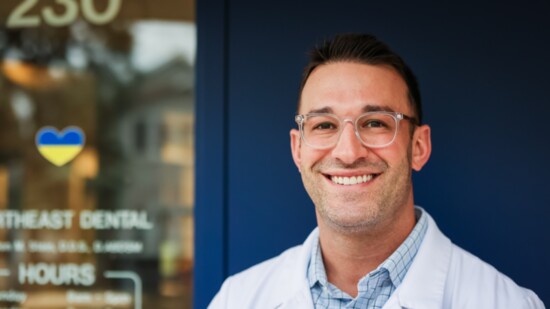Like most dentists, Dr. Ben Stein of Northeast Dental does everything from filling cavities to placing crowns. But, he also has another unique expertise.
“I became a diplomat with the American Board of Dental Sleep Medicine last summer,” he says. “I was first exposed to it when I became a resident after dental school and I took a lot of classes, but when I moved back to Minnesota in 2020, I worked at a snoring and sleep apnea dental treatment center with Dr. Jon Parker, who has been doing this for around 40 years.” After learning so much, Dr. Stein wanted to make sure his patients had the same opportunities.
Dental sleep medicine focuses on the treatment of snoring and obstructive sleep apnea, using an oral appliance to help patients breath at night. While many patients pursue CPAP machines to deal with their sleep apnea, some individuals cannot tolerate it.
“A dentist that is specially trained can provide an alternative treatment to CPAP, using an oral device,” says Dr. Stein. “Compliance and patient acceptance is generally higher, and ease of travel with an oral appliance is better. A lot of patients will use an oral appliance just for snoring too, it doesn’t have to be used only to treat apnea.”
Sleep apnea, he explains, is one of the most underdiagnosed medical conditions. Symptoms often include snoring, waking frequently, morning headaches, daytime tiredness, and mental fog. Oftentimes, people don’t even realize they have a problem until their sleep partner mentions it to them. Apnea means “cessation of breathing,” and is often related to the soft tissues of the mouth collapsing and blocking airflow.
Sleep apnea can lead to reduced quality of life and has a great impact on overall health. “When you stop breathing at night, your blood oxygen content will desaturate,” says Dr. Stein. “To replenish your oxygen, your heart has to work overtime, beating harder and faster to make up the deficit. This can lead to higher blood pressure and resting heart rate over time, which can increase risk for cardiovascular issues like stroke and heart attack.”
The four main factors affecting sleep apnea are age, weight, anatomy and hormones. Dr. Stein says as we get older, we lose muscle tone, including areas of the head and neck that help keep our airway open. Weight gain also adds more pressure to the throat and mass to the tongue, making it more likely to block the airway.
Other people are simply born with very narrow airways, which are prone to collapsing. “It’s like breathing through a straw all day long,” says Dr. Stein. Lastly, hormonal changes, specifically in postmenopausal women, will generally lead to a higher incidence of obstructive sleep apnea.
Treatment will, of course, benefit both the patient and his or her sleep partner, especially when it comes to snoring. “I would like to think I’ve saved a few marriages,” says Dr. Stein.
To diagnose sleep apnea, patients must participate in a sleep study, either at home or in a lab.
“When patients come to my office for a sleep consultation, the first step is a dental health evaluation,” he says. “We take necessary x-rays and perform examinations to make sure their teeth are healthy enough to use an oral device, and that there are no TMJ problems. Then, we’ll schedule a sleep study, and if they are a good candidate for an oral appliance, a medical doctor will give an order to have it made.”
If the sleep study reveals severe sleep apnea, or central sleep apnea (not obstructive), patients will generally start with a CPAP, which will provide a better chance for clinical success than an appliance. “If a patient just snores, or has mild to moderate sleep apnea, a dental appliance is often an appropriate treatment option,” says Dr. Stein. “We will take digital scans and measurements, and then send them to our specialized sleep laboratory to fabricate the appliance. This process generally takes two-three weeks.”
The oral appliance works by gently protruding the lower jaw to a prescribed position, which moves the tongue forward and out of the way so that it is not able to collapse and block the airway. Also, since roughly 80% of patients with sleep apnea grind their teeth, the appliance can provide protection for this grinding as well.
Dr. Stein says it's generally comfortable, but may take a few days to get used to. “At first, patients may experience a dry mouth or drool a bit. It’s also possible that the appliance could loosen a filling or crown, but that’s pretty rare. Lastly, there is a possibility for changes to your bite because by keeping the lower jaw forward, the muscles may relax into this new position. We make every patient a morning repositioner that helps guide the jaw back to its natural state, which is the best way to avoid any change to the bite. In my anecdotal experience, I would say 95% of patients will never notice a change to their bite.”
Follow up and oversight is a crucial part of treatment success. “Patients will come back for follow-up visits, where we clean and check on the integrity of their appliance, teeth, bite, and most importantly, make sure it’s working,” he says. In order to confirm this, Dr. Stein will likely recommend a follow-up sleep study, usually at home, while the patient is wearing their device.
To schedule a consultation with Dr. Stein in his downtown Minneapolis clinic, call 612-379-2300.
